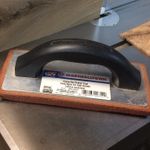Pain-Free Woodworking
Perfect wood, a dream shop and all of the tools in the world won't help your woodworking if you're hurt
Synopsis: Thomas P. LeRoy, a physical therapist and woodworker, offers tips on how to stand and work properly to avoid pain down the line. He explains how to stand in a neutral position, and then how to lessen strain on your neck. LeRoy details the lower back and how it acts as a stable base. He shows how to raise the work or lower your body to the work to ease physical strain, how to bend your knees instead of your back, and how to keep your belt parallel to the floor. Photos clearly show the right and wrong postures he describes, and the article includes stretching warm-up exercises, too.
How many times has this happened to you: You’re bent over for only two minutes, reaching under your router table to make that final depth adjustment. When you try to stand up—yeow!—it feels like someone has stuck a chisel in your back. It’s not just age; it can be a sign of cumulative trauma. Pain is a warning. Your back has just told you that the position you’ve worked in is a no-no. Keep it up, and someday the pain might not go away so fast.
I’m both a physical therapist and a member of the Guild of New Hampshire Woodworkers. Fellow members frequently tell me about aching backs, stiff necks and sore shoulders. These injuries don’t necessarily result from one specific incident, but rather they are often caused by prolonged overuse or misuse of your body. They are the proverbial piling on of straws that break the camel’s back. These injuries can happen to any body part, and they can range in seriousness from a small annoyance that decreases your enjoyment of woodworking to a debilitation that keeps you away from your workbench for long periods of time. Cumulative is the key word here. (The advice that I give in this article has to be somewhat general. If you have specific, intense injuries, you should consult your doctor.)
Get in neutral before you gear up
To get a good idea of how you can prevent cumulative trauma to your body while working, you will need to be comfortable with a few general concepts. First, each joint—a joint is where two or more bones meet—has a neutral position. This position exists roughly at the midway point between the joint’s extremes of motion. When a joint is in neutral, it is in its least stressed position. Think of a balanced seesaw, with the plank horizontal, and you have a simplified paradigm of a joint in neutral. Turn your head as far to the right as you can and then to the left. The neutral position for your neck in this plane of motion is facing straight ahead, midway between the extremes.
The farther a joint is out of neutral, the more stress there is on the joint surfaces, the surrounding muscles and their tendons. The more time spent out of neutral also increases the load on these structures. Stress and load cause fatigue and, possibly, pain. These facts lead us to the second concept: To decrease the factors that can lead to cumulative trauma injuries (read pain), you must spend more time closer to your neutral positions.
Often, mere awareness of proper work positions is not enough. Your overused muscles can get tight during a day in the shop.
From Fine Woodworking #137
For the full article, download the PDF below:
Fine Woodworking Recommended Products

Rockler Dust Right 1250 CFM

Fein Turbo II HEPA Wet/Dry Dust Extractor

Grout float




















Comments
Timeless article, excellent. Just what I needed.
Log in or create an account to post a comment.
Sign up Log in